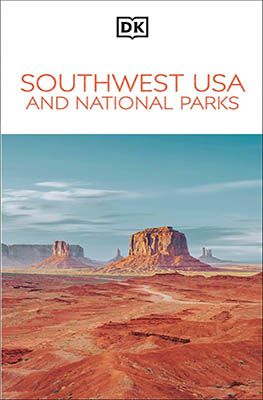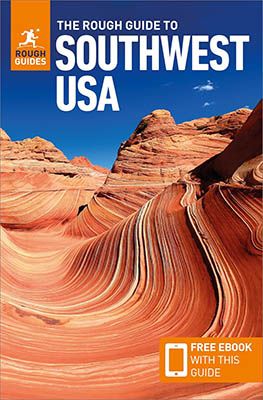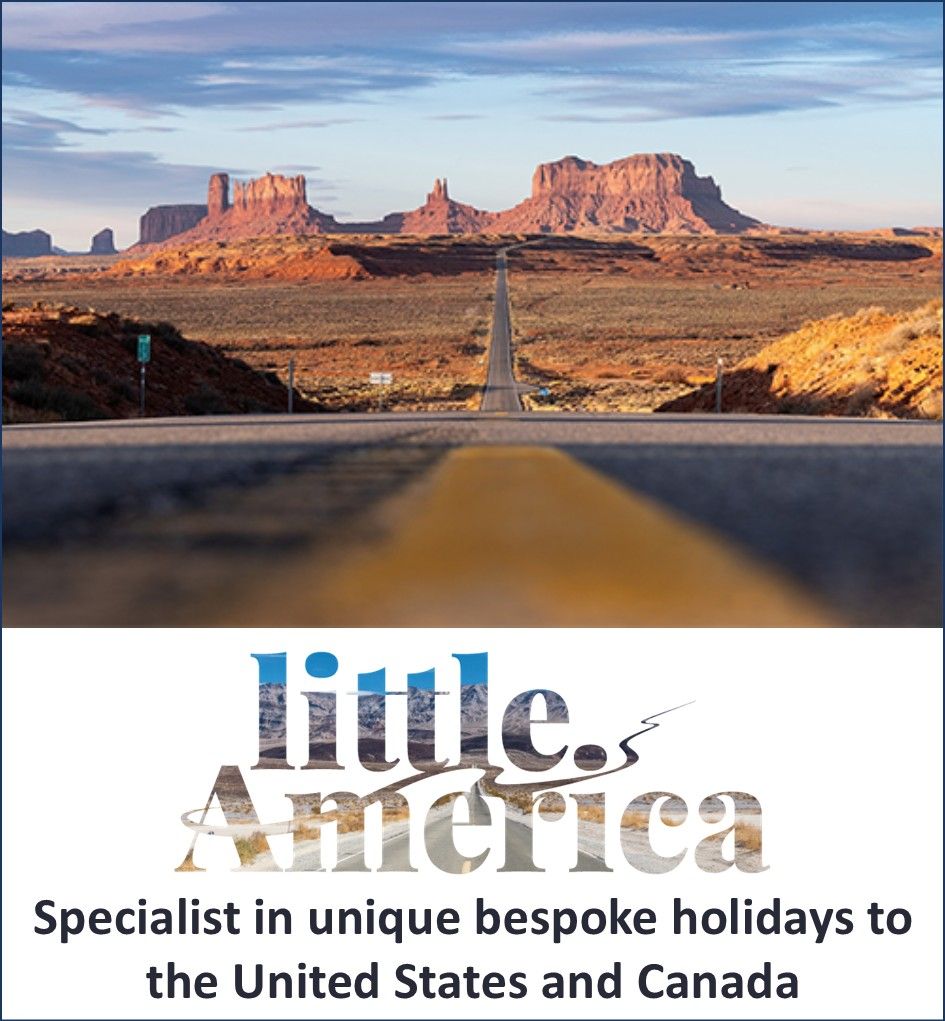Southwest America is a dream for nature lovers. Think of enormous canyons, bizarre rock formations, giant trees and endless views. The best part? These places are accessible to visit. During our road trip through America, we visited the most beautiful national parks of Southwest America. Each park was different, but they all had one thing in common: the landscapes are spectacular and surreally beautiful. Before we guide you through all those parks, we’ll first share some tips. Because with these, you’ll enjoy all that fantastic nature even more!
In this blog ...
- Essential: The National Park Pass
- The Visitor Centres: The Real Starting Point
- The Most Beautiful National Parks of Southwest America
- National Parks in Southwest America on Our Bucket List
- Which National Parks in Southwest America Do You Want to See?
- Frequently Asked Questions About the National Parks in Southwest America
- Other topics you may be interested in
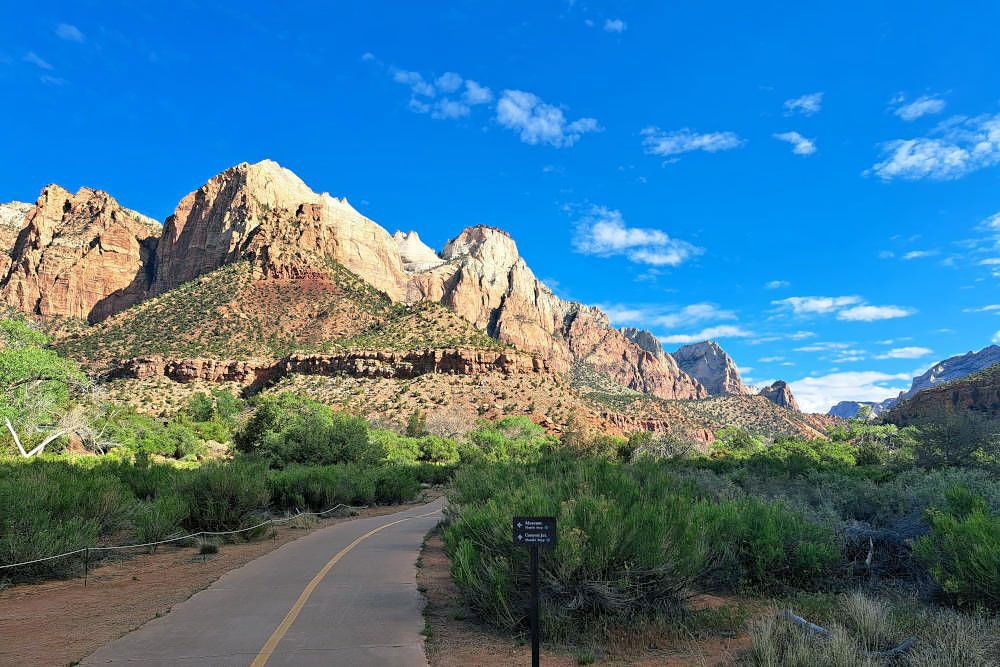
Essential: The National Park Pass
Upon arrival at Yosemite National Park, we purchased an annual pass. This pass gives us access to all national parks and national monuments. The “America the Beautiful Pass” costs around 80 dollars (2025 price level, see the website for current prices). The annual pass gives us access to more than 2,000 federal recreation areas, including all national parks. One pass per vehicle for a maximum of 4 people is needed. This saves us from buying individual entry tickets each time (prices vary but are around $30 per park). A good investment, as we want to visit the most beautiful national parks of Southwest America.
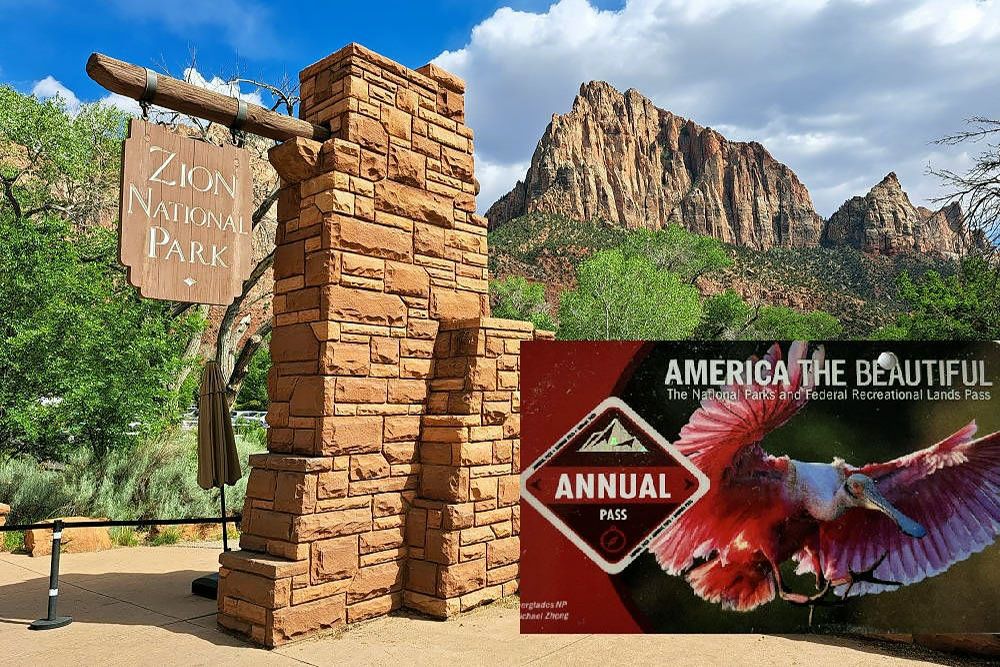
The Visitor Centres: The Real Starting Point
For us, each park begins with a visit to the park’s visitor centre. There we meet friendly Rangers who advise us on the most beautiful hikes and highlights. We always have an animated conversation with such a park ranger. They ask good questions and can then give targeted advice: which trail is worth the effort, what are the most beautiful places we shouldn’t miss, are all routes open, and so on.
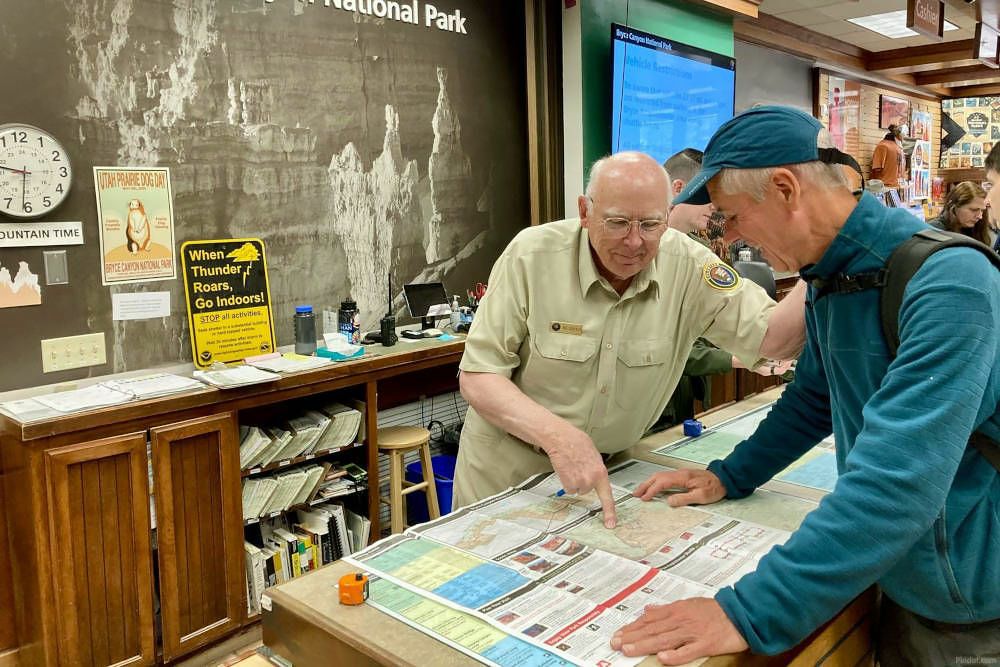
The Most Beautiful National Parks of Southwest America
According to us, these are the most beautiful national parks of Southwest America. Want to know more about these parks? We’ll write more extensive blogs about the visited parks later.
Yosemite National Park (California)
Yosemite NP is grand, rugged and green. The park is located in the Sierra Nevada and is particularly known for its granite rock faces, waterfalls and spectacular views. And did you know that you can also admire enormous sequoia trees in Yosemite?
We have a beautiful log cabin near Wawona. That’s in the southern and less well-known side of the park. From our accommodation, a quiet but surprisingly beautiful walking route starts to the Chilnualna Falls. Along the way, we encounter few people. We hear only the sound of flowing water and birds. At the top of the waterfall, we enjoy a beautiful view. An ideal place to have lunch with the sound of the cascading water in the background.
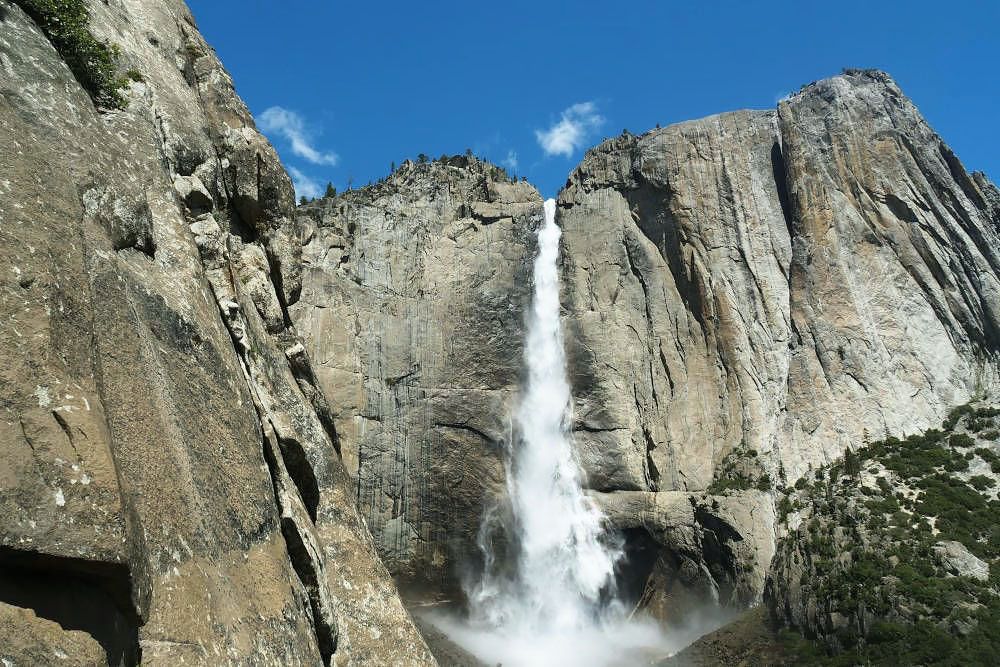
The next day, we go for the real climbing work. We walk to the top of the Yosemite Upper Falls. This is no easy feat; it’s challenging with regular rocky passages. But once we’re at the top, we forget all the efforts. We have a fantastic view.
The Mariposa Grove at the southern entrance is an area full of sequoia trees. We feel tiny next to these giants. The walking paths are well laid out and lead us to impressive specimens. When we walk a bit further, we leave most visitors behind us.
For viewpoints, you’re definitely well-served in Yosemite. Think of Glacier Point, Tunnel View (classic picture with El Capitan and Bridalveil Fall) and Taft Point (exciting, as you look straight into the depths without a fence). We have visited Yosemite before and have written an extensive blog about it.
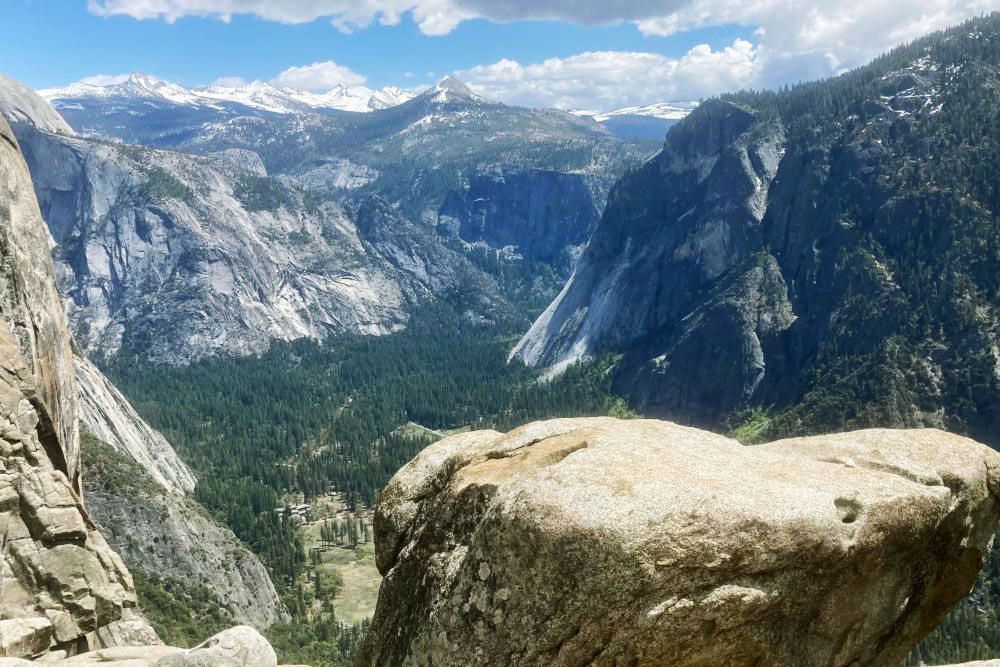
Sequoia and Kings Canyon National Park (California)
Sequoia and Kings Canyon NP is completely different from Yosemite, but just as impressive. Of course, we visit the largest tree in the world: the General Sherman Tree. From the visitor centre, it’s a short walk along a well-maintained path. It is literally and figuratively the biggest attraction of the park. This forest giant is over 80 metres tall and has a maximum circumference of over 30 metres. Not surprising that it’s busy there; everyone wants to have their photo taken with that tree. And then it really becomes apparent how big that tree is.
From the General Sherman Tree, we walk the Congress Trail. It’s a beautiful loop through the forest where we soon don’t encounter any other people. It’s quiet here. Just us, those colossal trees and the smell of resin and earth.
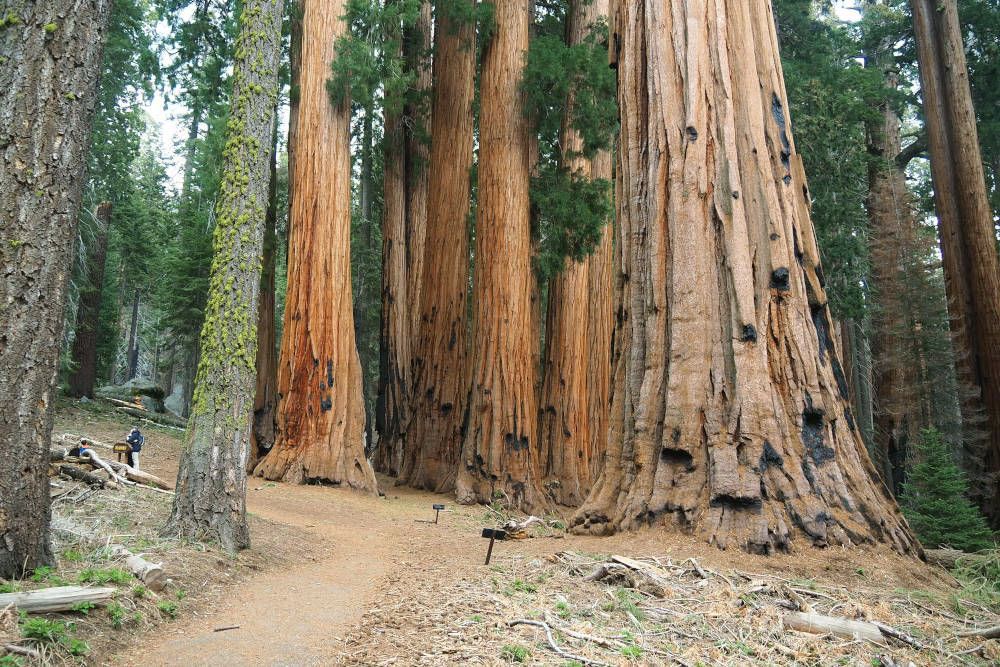
Due to the rising mist, the view becomes even more mystical. Unfortunately for us, this makes a visit to Moro Rock impossible. On the way there, we can’t see a hand in front of our eyes. Cars turn around and drive back at walking pace; we do the same. Thus we miss the phenomenal view over the valley and the surrounding mountains.
Another natural highlight is Crystal Cave. This beautiful marble and limestone cave offers a fascinating underground world with remarkable formations. Unfortunately, the cave is not yet open during our visit.
Luckily, there’s still plenty of beauty left. We walk through the Giant Forest. This is one of the most visited places in Sequoia. Here we find thousands of gigantic sequoias, including four of the five largest in the world. The Giant Forest Museum is located nearby. A nice place to learn more about the origin of these forest giants.
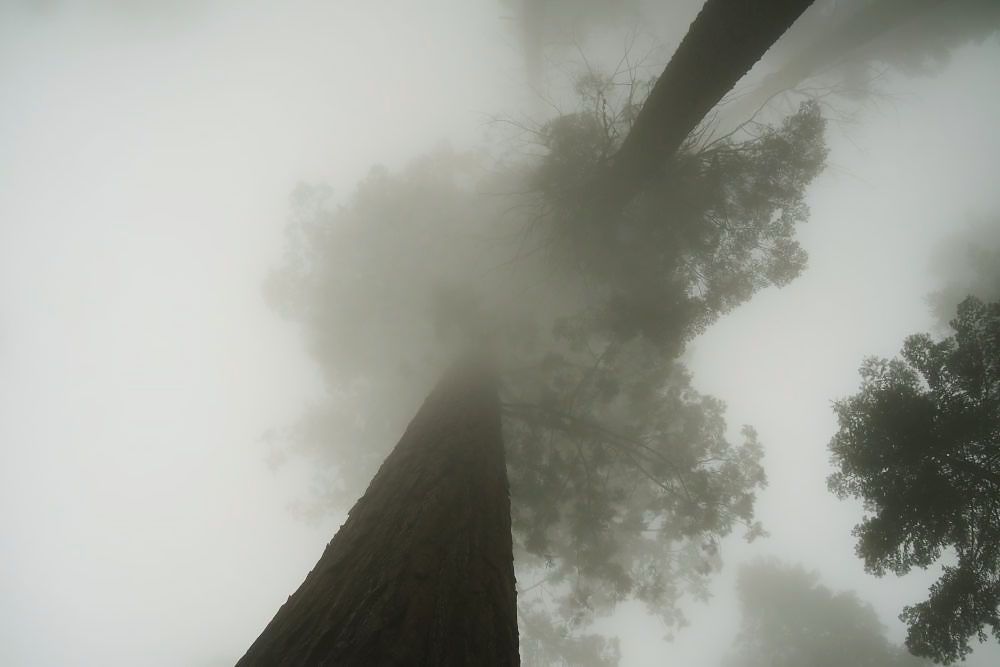
Joshua Tree National Park (California)
In Joshua Tree NP, you won’t find deep gorges or towering trees, but a desert full of bizarre boulders and of course the famous Joshua trees. The most fun is to search for the tree that was on the cover of U2’s album “The Joshua Tree”. Small disclaimer: that specific tree is now dead, but comparable specimens can be found everywhere in this park. We didn’t visit Joshua Tree NP on this road trip because we were here some time ago. We wrote an extensive blog about Joshua Tree NP then.
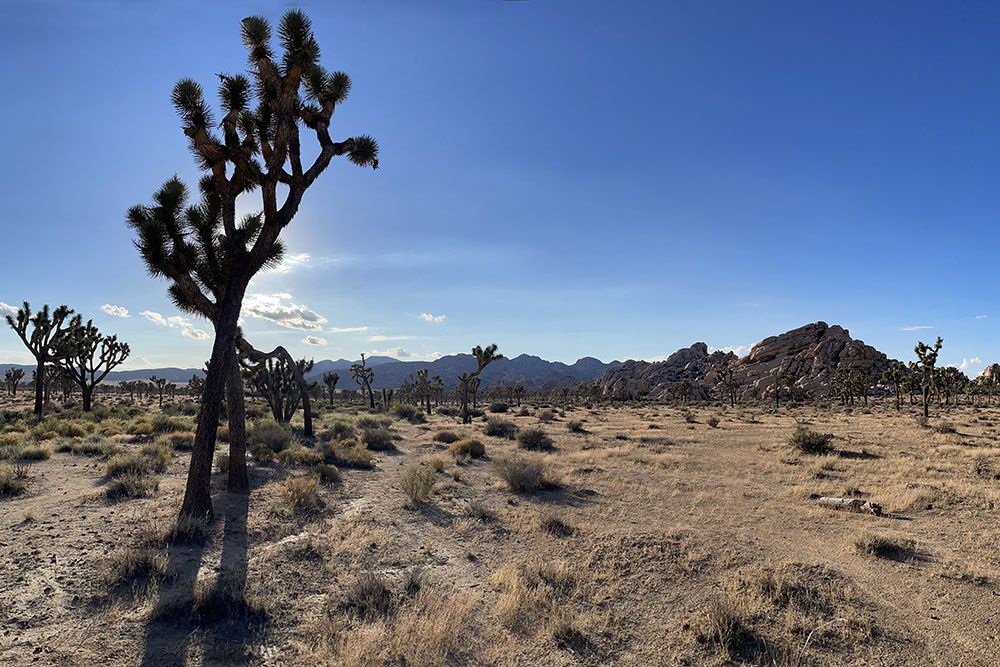
Death Valley National Park (California/Nevada)
It sounds ominous, but Death Valley NP is beautiful in its extremes. Hot, dry and rugged. The heat there is enormous. We are there in early May and it’s already 35 degrees. In summer, it can even reach 50 degrees. During that period, you’d better avoid Death Valley. For us, it’s just bearable.
From our wonderful accommodation in Tecopa, we make a tour through Death Valley. First, we visit the Badwater Basin. This is the lowest point in North America, about 85 metres below sea level. We walk across the immense salt flat. We also visit the Natural Bridge. This unique natural phenomenon is an imposing arch. A bridge of rock, carefully carved out by thousands of years of erosion. The Devil’s Golf Course is also such a special natural phenomenon. It’s a vast plain covered with irregular salt crystals. We see millions of sharp, jagged shapes here. They are so rough that you can imagine only the devil could play a ball here.
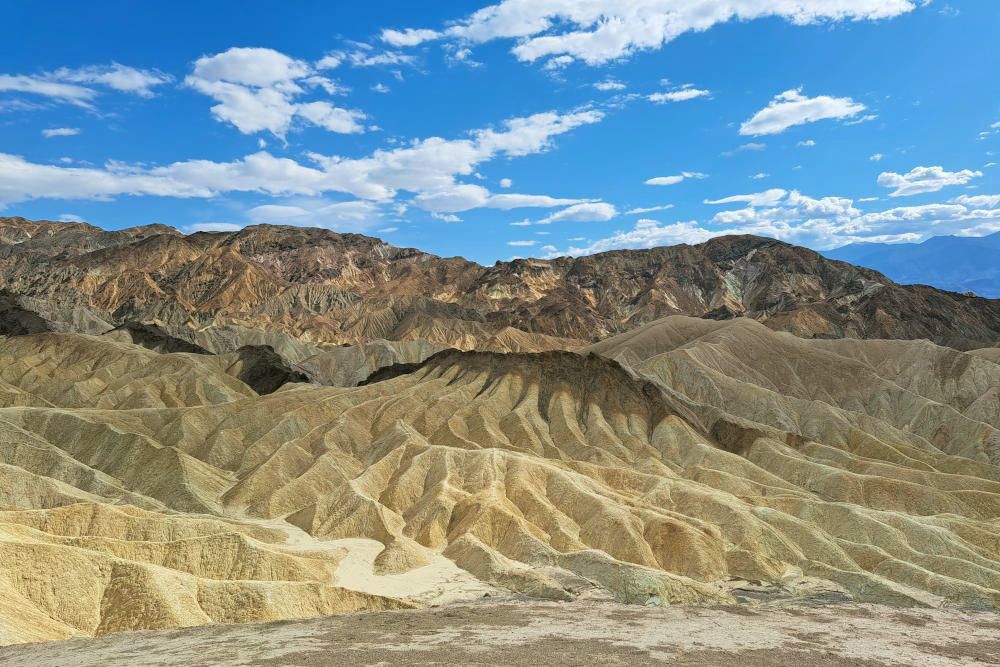
Two of the most breathtaking lookout points in Death Valley are undoubtedly Zabriskie Point and Dante’s View. From Zabriskie Point, we see an unforgettable lunar landscape of eroded sandstone hills; yellow, brown and gold-coloured. In undulating patterns, they seem to roll into the valley. Nearby, Dante’s View offers us a panoramic view that encompasses almost the entire Death Valley. From this high point, we can see both the Badwater Basin and the surrounding mountain ranges. The landscape here is so immense that we feel tiny. At the same time, we experience the grandeur of nature with full awe.
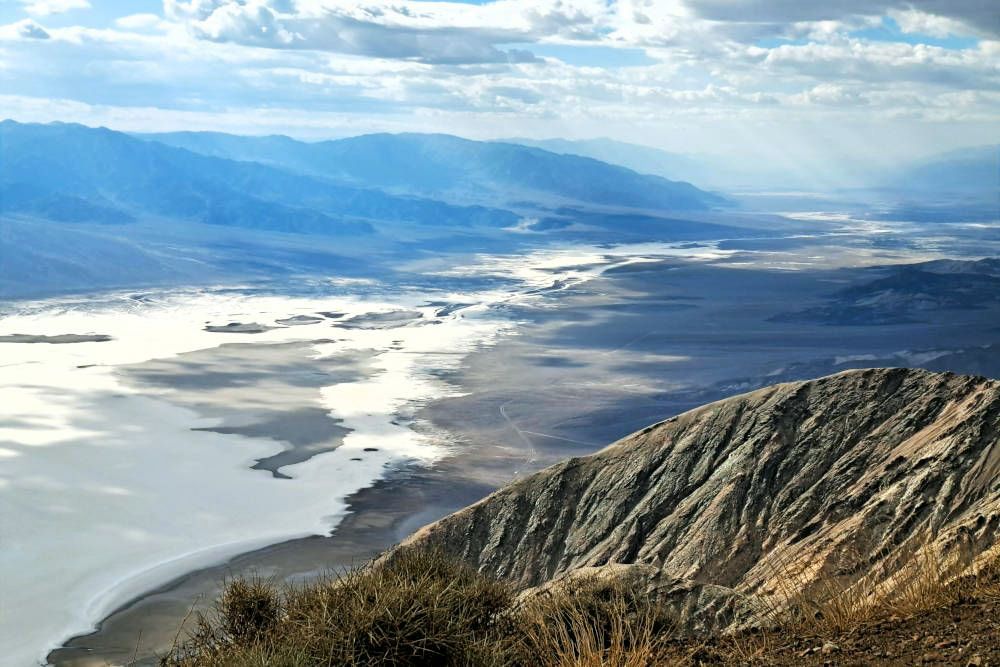
Zion National Park (Utah)
Zion NP feels like an oasis in the desert. Countless red-coloured rocks, a winding river and lots of greenery. The most fun way to explore the park is with an e-bike. We do this one morning with our guide from Zion Guru. We are allowed to ride it along the scenic drive. This route takes us past all the highlights of the park. The stops are numerous, as we want to take photos everywhere.
Hiking in Zion is also possible, of course. There are various walking routes. We take a walk to the Emerald Pools. There are three levels, Lower, Middle and Upper. The paths are not too strenuous and along the way we pass small waterfalls and green oases. It’s a popular trek; we certainly aren’t walking alone. The most spectacular hike in Zion NP is “Angels Landing”. We skip this one, given its difficulty and narrow passages at great heights. For the adventurer who wants to do this hike: a permit is required.
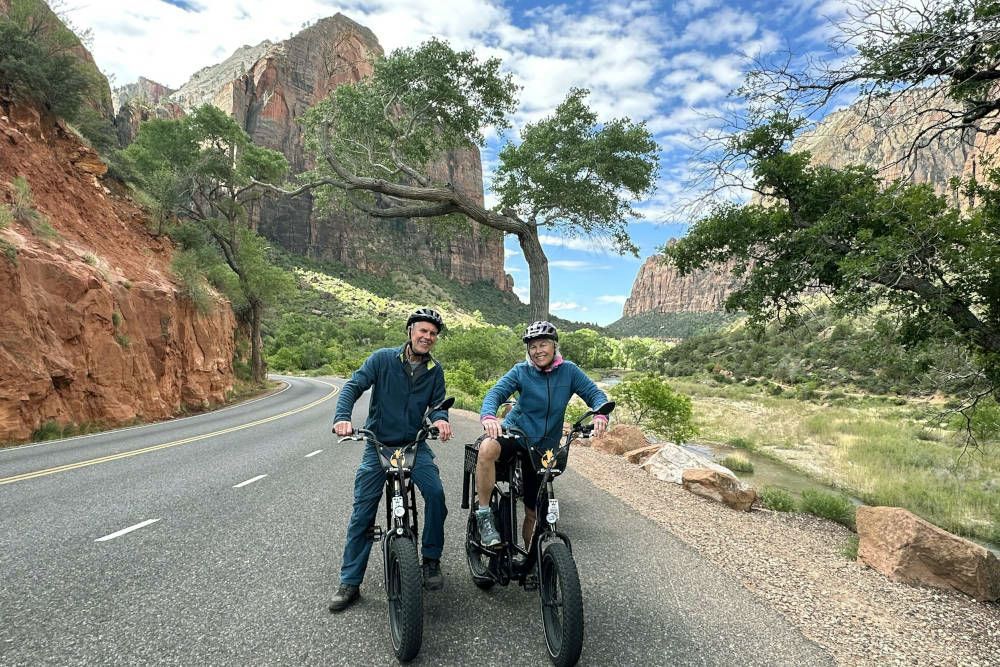
Perhaps the most famous hike in Zion NP is the “Narrows”. Here we literally walk through the river, between the high canyon walls. In our special outfit, we don’t suffer from the fast-flowing water. The wooden walking stick provides much-needed support. The further we walk, the quieter it becomes. Around us those immense rocks, before us the water glitters in the sun. A unique experience! You can rent equipment for this special hike at various places. We did this at Zion Outfitter, not far from the Visitor Centre.
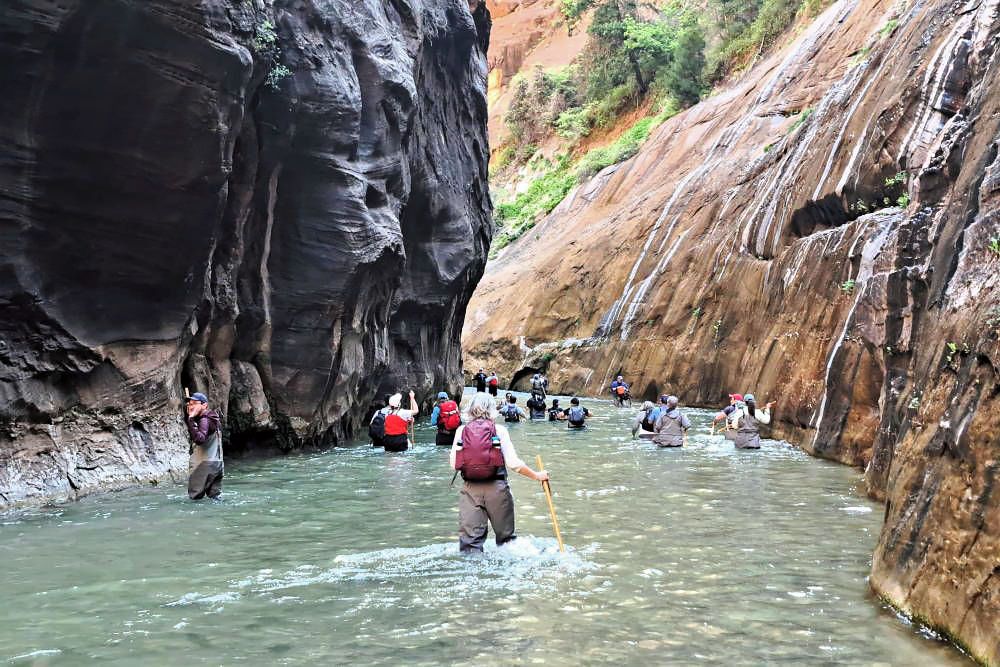
Bryce Canyon National Park (Utah)
Bryce NP is not far from Zion, but is completely different. Here it’s all about the hoodoos: towering pillars of rock. They often have whimsical, irregular shapes that resemble totem poles, people, animals or fantasy figures. The hoodoos can vary in height, from human height to more than ten storeys high. They are often beautifully layered in red, orange, yellow and white tints. It looks like an immense amphitheatre.
We start with the Rim Trail. Here we walk along the edge of the canyon, with ever-new, spectacular views. All around us we see the bizarre rock formations; one moment brightly coloured by the sun, the next moment in the shadow of a cloud.

The Navajo Loop Trail takes us to the bottom of the amphitheatre. We slalom between the hoodoos, sometimes so close we can almost touch them. An unforgettable experience! We combine this with the Peek-a-boo Loop, a more challenging trek that leads us even deeper into the “gardens” of hoodoos. The paths wind and the views are phenomenal.
Lastly, we walk the Queens Garden Trail. Here we find ourselves in a fairy-tale world. The paths are easier to navigate and lead us along unique hoodoos. Including the famous Queen Victoria. Everywhere we look, we see nature in its most creative form. Bryce Canyon has stolen our hearts!
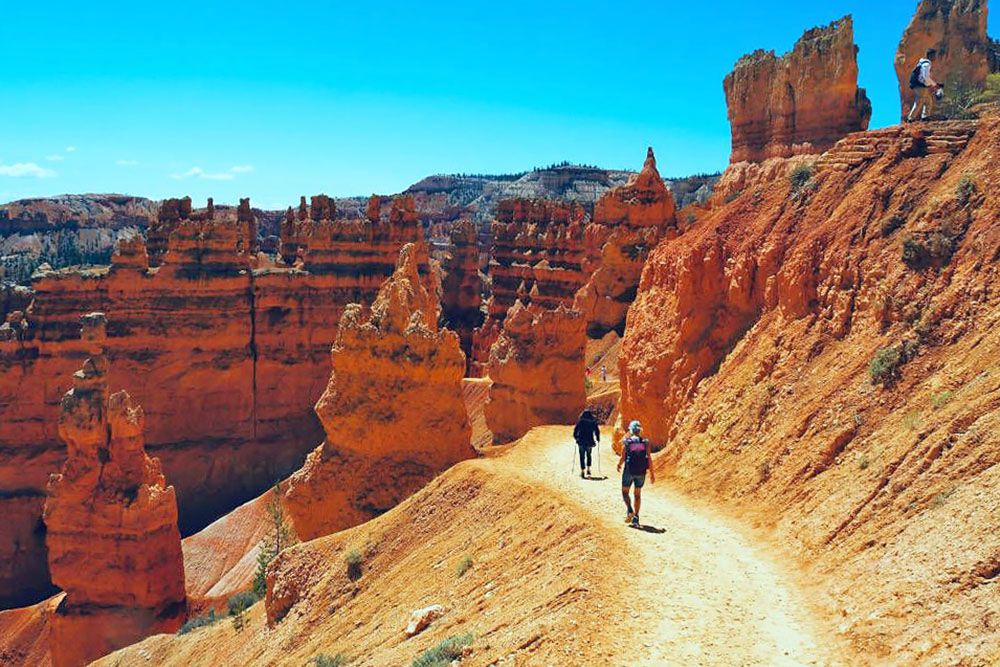
Grand Canyon National Park (Arizona)
The most famous canyon of them all. The North Rim, the northern part of Grand Canyon NP, was still closed during this trip. And the southern part wasn’t on the route. Fortunately, we visited this park a few years ago. In our separate blog, you can read all about the highlights of Grand Canyon NP.
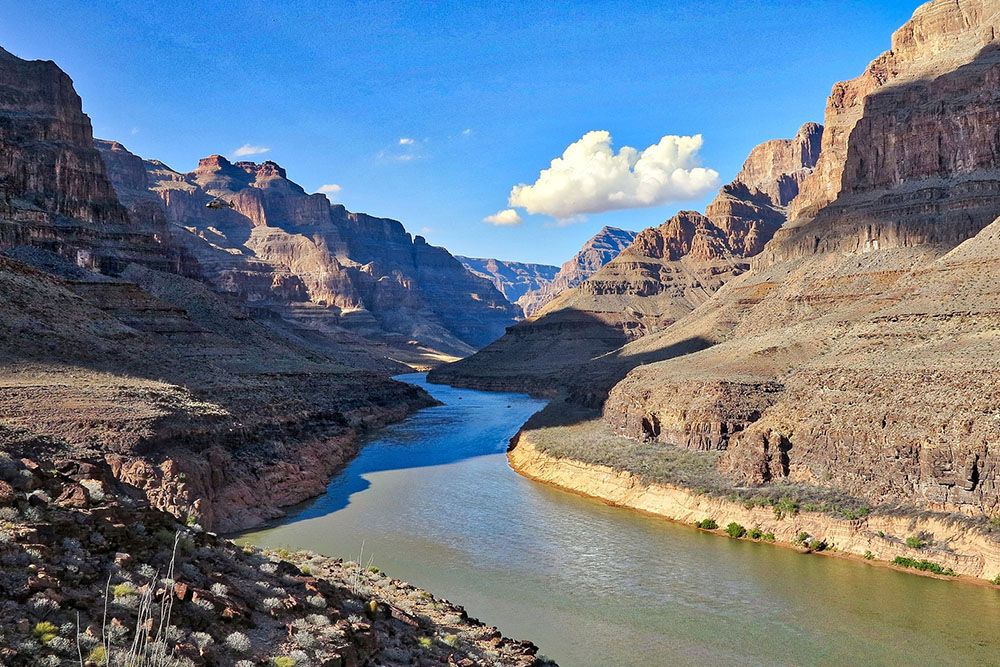
National Parks in Southwest America on Our Bucket List
We took ample time for each park. As a result, we couldn’t visit other parks. There are two parks that shouldn’t be missing from this overview. Hence, we mention them briefly:
Arches National Park (Utah)
In this park, it’s all about natural stone arches. Some are large, others small, but all equally photogenic. Utah’s icon can be found here: Delicate Arch. The hike to it is challenging, especially in hot weather. But the view makes it all worthwhile. Other recommendations are: Landscape Arch (the longest natural arch), Double Arch (two arches above each other) and The Windows Section (many arches close together). The nice thing about Arches NP is that you can see a lot of beauty with short walks.
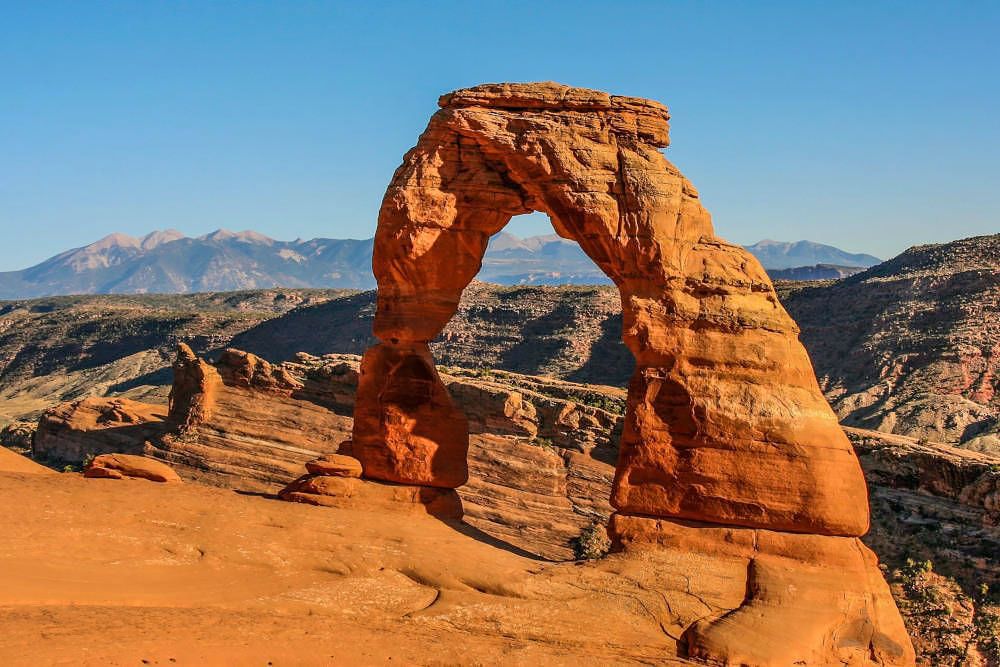
Capitol Reef National Park (Utah)
Capitol Reef NP is a less well-known park, but certainly no less impressive! This park feels like a hidden gem in Utah. The park is dominated by the Waterpocket Fold, an almost 160-kilometre-long ripple in the Earth’s crust. This geological fold creates spectacular cliffs, canyons and domes. Via the Scenic Drive through the park, you have a view of all the impressive highlights. In this park, you also encounter various fruit orchards.
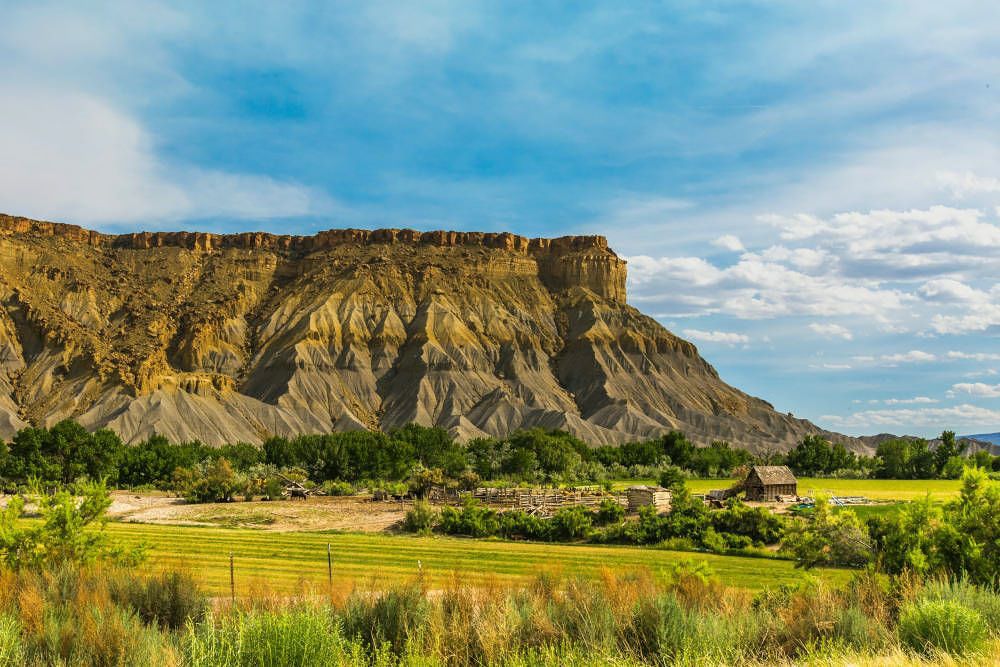
Which National Parks in Southwest America Do You Want to See?
Whether you come for the views, the tranquillity or the adventure, this area won’t let you go. And the best part? Each park feels like a world of its own. Grab your hiking boots, rent that e-bike, set your alarm for an unforgettable sunrise. Believe us: you won’t regret it. Take ample time for each park; it would be a shame to rush from one highlight to another. Better to explore a few parks well than to see them all without truly experiencing the natural splendour. And keep in mind that in the high season, you must reserve access to certain parks. In the coming time, we’ll write more extensive blogs about the visited parks. Stay tuned and read more about the most beautiful national parks in Southwest America.
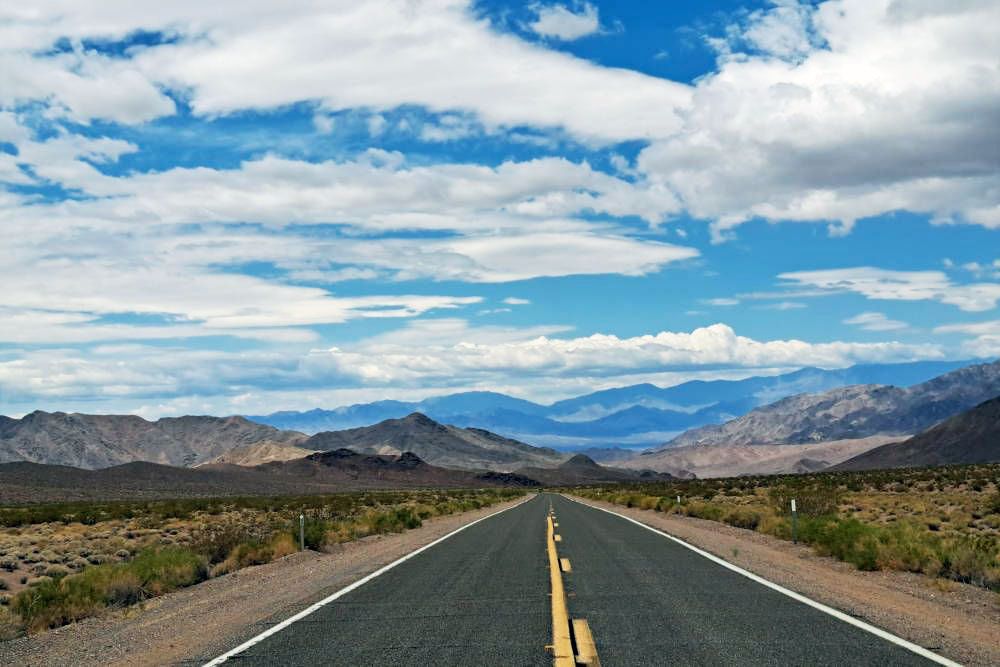
Frequently Asked Questions About the National Parks in Southwest America
Yes, the national parks in the US charge an entrance fee. This is usually per vehicle and is valid for a week for that specific park. So you can visit the park multiple times in that week. The costs vary per park, but are often around $30-$35 per vehicle.
For most parks, no reservation is needed; you can just drive in and pay on the spot. However, for some very popular parks or specific routes, a reservation may be mandatory during busy periods. Always check the official NPS (National Park Service) website of the relevant park before your departure. We have already mentioned the link for each park in the description in the blog.
Absolutely! If you plan to visit three or more national parks within one year, then the “America the Beautiful – The National Parks and Federal Recreational Lands Pass” (often called the “Annual Pass”) is the best option. This costs $80 (2025 price level) and gives a year’s access to all national parks and many other federal recreation areas for you and your passengers in one vehicle.
Yes, in most parks, you can drive your own car or campervan on the designated roads. Keep in mind that some parks (like Zion National Park in the high season) have a mandatory shuttle system for the main routes to regulate the crowds. Larger campervans may have restrictions on narrow, winding or steep roads.
Spring (April-May) and autumn (September-October) are generally considered the best periods. The temperatures are pleasant then, ideal for hiking, and the crowds are less than in the summer months. In summer (June-August), it can become extremely hot, especially in Death Valley. The winter months bring cold weather and snow. Parts of certain parks may be closed then, like the North Rim in Grand Canyon NP.
That’s very personal! Each park has its own unique charm. The Grand Canyon is iconic, Zion is known for its red rock formations, Bryce Canyon for its hoodoos, Sequoia for the enormous forest giants and Arches for its natural arches. It really depends on your preference for landscape and activities.
The Grand Canyon (especially the South Rim) is the most visited national park in Southwest America. This park is even one of the most popular parks in the entire US. Yosemite and Zion are also very popular with visitors.
We chose to make our road trip through Southwest America with a rental car. That worked well for us. The campervans are generally very large, making it more difficult to drive on some winding and narrow roads. Some roads are also not accessible for larger campervans. Additionally, we didn’t find the campsites that nice. If you’re considering travelling with a campervan, you should reserve a camper spot well in advance.
We sought advice from Little America, specialists in tailor-made holidays in America and Canada. Based on our personal preferences and interests, Little America put together an unforgettable journey for us. The various accommodations were small-scale, often beautifully situated in nature.

